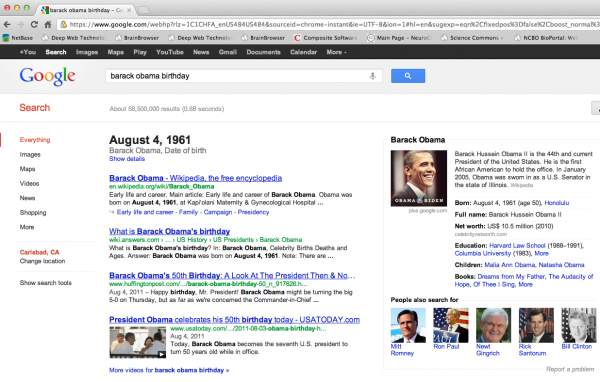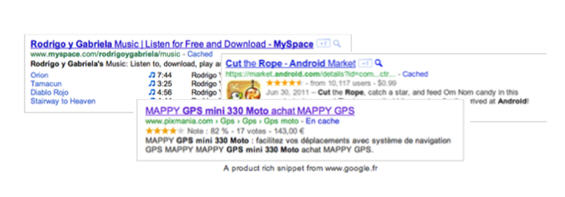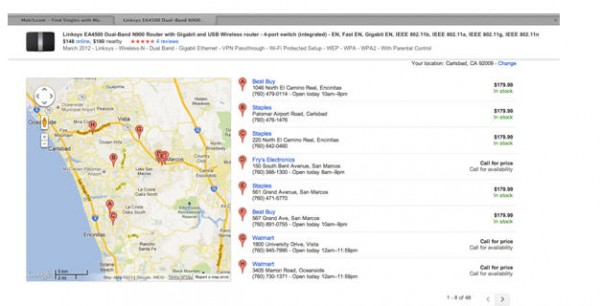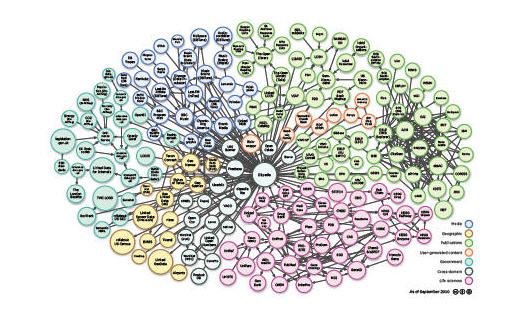Can Retailers Benefit From The Knowledge Graph & Schema? You Bet!
The Knowledge Graph is the latest in a series of efforts in which Google has adopted technology from the semantic web aka the “Giant Global Graph” envisioned by Tim Berners-Lee. For those retailers who haven’t yet adopted schema.org microdata, Good Relations RDFa and other structured markup on their product pages, now is the time to […]
The Knowledge Graph is the latest in a series of efforts in which Google has adopted technology from the semantic web aka the “Giant Global Graph” envisioned by Tim Berners-Lee. For those retailers who haven’t yet adopted schema.org microdata, Good Relations RDFa and other structured markup on their product pages, now is the time to take advantage of the newly implemented Knowledge Graph technology.

Image from Shutterstock, by drserg, used under license
Will Google’s Knowledge Graph have an effect on retail? Absolutely! It already has.
Google has been moving toward adoption of semantic web technology for quite some time. It started with rich snippets for enhanced displays and continued with support for schema.org microdata.
Following is a chronology of events moving toward the semantic web:
- Yahoo! opens Search Monkey: February 2008
- Google introduces reviews and aggregate reviews using rich snippets: May 2009
- Google introduces RDFa support for videos: September 2009
- Google encourages webmaster to “help us make the web better” by using rich snippets: October 2009
- Google announces use of structured data to describe an organization: March 2010
- Google announces rich snippets for recipes: April 2010
- Google announces “Rich Snippets Go International”: April 2010
- Facebook announces Open Graph protocol based on RDFa: April 2010
- “Google Acquires MetaWeb“: July 2010
- Google Refine is announced: November 2010
- Google announces rich snippets for shopping sites: November 2010
- Google, Yahoo!, and Bing announce Schema.org: June 2011
- “Rich snippets can help you find music more easily”: August 2011
- Rich snippets for apps: September 2011
- “Rich Snippets for Shopping Sites”help users quickly identify the sites most likely to have the most relevant products for their needs”: Feb 2012 (international launch – certain countries only)
- “Shopping Rich Snippets Supported Globally”: April 16, 2012
- “Introducing the Knowledge Graph, things not strings”: April 16, 2012
After Google’s Metaweb acquistion, the search engines were all becoming, in baby steps, what I would call “answer engines.” Typing in a query such as “Barack Obama birthday” would yield an answer. I tried it again recently and the result was amazing!
Placing semantic markup on your webpages makes them more findable. For shopping sites, the markup information can leveraged so users quickly identify sites that have only the relevant products they seek. Some examples of rich snippets are shown below.
Google is now leveraging linked data within the enterprise, which is very clear within the “Knowledge Graph,” and in some fashion, they are doing so with the consumed information from rich snippets, namely retail, reviews, etc. In this case we specifically refer to the retail aspect and its associated domains/schemas.
I actually experienced the benefit of rich snippets myself recently when my router was acting up and I needed a new one. I wanted to purchase an N900 Linksys router. All that properly marked-up data, or consumed knowledge, sent me on a very efficient search to acquire a router. I typed in the search query “NL900 LinkSys” and found the following item close to the top of the screen.
I selected the little red button for nearby stores, and got the following screen:
It was a Sunday morning, so my son and I anxiously awaited the opening of Best Buy, which is just around the corner. They were all priced the same at all the stores, and Best Buy was the closest and had the item in stock. I purchased it right away, went home and installed it.
The Google Merchant Center states that information may be submitted either via a product feed, or by onscreen markup. So there are two mechanisms you can use to give Google that structured data.
If you’re still not a believer, I refer you to this post on ecommerce blog Get Elastic, where it shows how some recent search results seem to get extra search engine love by using semantic SEO technology. It also reveals that Productontology extends Schema.org and GoodRelations’ standards for ecommerce markup by supporting over 300,000 product type identifiers. I recommend that retailers read this blog post.
At this point you may be asking, what do rich snippets have to do with the Knowledge Graph? Here is where a little understanding of the semantic web may come in handy.
Rich snippet markup is consumed by search engines. Crawlers consume this information and they “create a web of data” that can be stored in a database. Below is a Linked Open Data Diagram – September 2011.
The Central bubble in the middle of the diagram is Wikipedia. You can also see Freebase in the diagram. All the data is relationally linked, verified, curated, etc. Google is also partially funding/sponsoring the Wikidata project. I think this gives a strong perspective on the “Knowledge Graph” and the move on Google’s path to know things rather than just recognizing them. I’m sure the Knowledge graph is just another strong step in that direction.
Does Structured Data Improve Site Rankings?
I frequently get asked this question by my clients: “Will using structured markup improve my site’s rankings in Google? Google says the following:
“Google doesn’t use markup for ranking purposes at this time—but rich snippets(*) can make your webpages appear more prominently in search results, so you may see an increase in traffic.”
However, as Phil Barker says on his blog, “It would be better to ask ‘will schema.org metadata help people find my pages using Google,’ to which the answer is yes if Google decides to use that mark up to enhance search result pages and/or provide additional search options.
My take is: thanks to the Knowledge Graph, there is a good chance structured data markup will make your rankings more visible to users searching for your products when your pages are related to specific product queries. In fact, it will improve your findability and make your web page more relevant to Google, which has a direct impact on both CTR and ultimately, conversions.
Will the Knowledge Graph Affect Rankings?
Google algorithm changes always seem to shake things up for many websites. Google says this change shouldn’t make much difference for the typical website; the Knowledge Graph will display on the right side and should not affect rankings.
However, others feel differently, as in David Cardinal’s article on ExtremeTech, which says “Web publishers get cut out of the loop, risking their business models and ability to create the content that we all rely on.” That’s another view, and the impact of Knowledge Graph technology remains to be seen.
In conclusion, let’s count the ways that retailers can benefit from Google’s Knowledge Graph technology, and especially those that use semantic web markup.
- Increase in CTR
- Eliminates ambiguous language so search results are less confusing
- Creates an easy-to-understand summary of the search query
- Helps illustrate connections between different topics
- More potential for SERP visibility for your products
- Makes your product pages more findable
- Shoppers quickly exposed to your listings when searching for your products
- Shoppers get answers to specific product queries with local directions
- Google helps shoppers navigate a product search without having to fine-tune their search terms
Since not many retailers have adopted structured markup on their product pages, you can get ahead of your competitors by doing so now.
Image by drserg / Shutterstock.com, used under license
Contributing authors are invited to create content for Search Engine Land and are chosen for their expertise and contribution to the search community. Our contributors work under the oversight of the editorial staff and contributions are checked for quality and relevance to our readers. The opinions they express are their own.
Related stories




